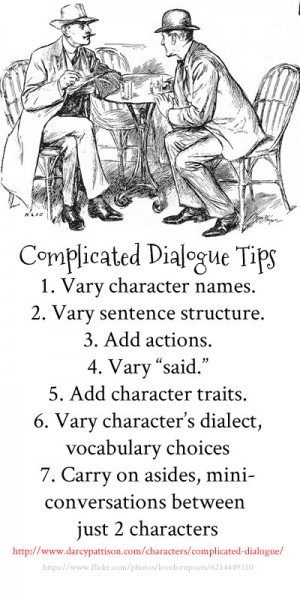Today, I’d like to answer a question from a reader.
Shena asks, “I’m writing a story and I have five people who are carrying on a conversation with each other. How do I go about stating each person’s line without constantly using, he said, he replied or using the person’s name to say this person said after the sentence without it being an overkill of redundancy?”
Thanks for the question! You’re right to be concerned about repeating speech tags too often. It’s really a balancing act: on one hand, you don’t want to repeat too often, but neither do you want the reader to get lost. You have limited options, however, and you’ll have to work hard to keep this conversation interesting.
Speech Tags
Speech tags are the “he said” and “she said” that often accompanies dialogue. Notice that when you use HE or SHE, they are pronouns and will refer to the person immediately preceding. That’s important. The pronoun antecedent must be the right person. In the case of five people talking, you’ll probably need to use the character’s name often.\
James said, “Get lost.”
Jim said, “No way?”
Jill said, “Why?”
In the example above, notice that the job is even harder when character’s names all start with the same letter. Make sure your novel is populated with characters who have unique names that stand in contrast to one another. Not Jill and Bill, because they rhyme. Not James, Jim and Jill because they all begin with the same letter and are all one syllable. Instead, choose something like this: James, Brianna, Marguerite, Ally, and Bob.
Actions in the Midst of Dialogue
Dialogue rarely stands alone, though. When you add actions to dialogue, it’s sometimes called beats. This isn’t the same as action beats in a scene, but instead just means the small actions that are interwoven with dialogue. Sometimes those are the same, but sometimes not.
Dialogue beats are the small actions. Scenes demand actions, not just interior thoughts. What are your characters doing? Changing a light bulb.
James took the light hub out of the package and said, “Get lost.”
Reaching in, Marguerite gently took the package from him and said, “No way.”
Ally stuck out her lip in a pout. “Why?”
Notice here that Ally has an action, but has no speech tag. Sometimes, you can just omit the speech tag, if a character does something right before or after the dialogue and it’s clear that it’s this character speaking.
This still sounds boring, though. Part of that is because we repeated the structure too exactly in the first two sentences. They have an “action and said,” structure, which doesn’t really work here. Vary the structure of your sentences, sometimes putting the dialogue first, last, or even in the middle of the action.
Bob shook his head in disgust.
James tore open the light bulb package and snarled, “Get lost.”
“No way.” Marguerite’s voice was soothing and gentle. She took the torn cardboard from James and patted his shoulder.
Ally stuck out her lip in a pout. “Why should I get lost?” She hesitated and added, “I don’t want to.”
Bob grunted, “Why? Isn’t it obvious?”
“James is just upset,” Brianna said, “But that doesn’t mean he should get his way.”
Notice the variety here.
- There are some actions without dialogue.
- Dialogue occurs at the end, the beginning or the middle of the dialogue.
- After some dialogue, there’s a longer section of actions.
- I’ve used two substitutes for “said”: snarled and grunted. I don’t like using very many substitutes. Many writers explain that “said” disappears and readers don’t notice it. If you use an alternate word, it should add something important to the story.
Character Tics and Tags
Finally, it’s possible to use character tics or tags to good effect. Perhaps, poor Ally stutters. And James has a high pitched voice.
Bob shook his head in disgust.
James tore open the light bulb package and whined in soprano, “Get lost.”
“No way.” Marguerite’s voice was soothing and gentle. She took the torn cardboard from James and patted his shoulder.
Ally stuck out her lip in a pout. “W-w-why should I get lost?”
“Especially you!” James squeaked.
“W-w-why?”
Bob threw up his hands. “Why? Isn’t it obvious?”
“James is just upset,” Brianna said to Ally, “But that doesn’t mean he should get his way.”
You can start to see how dialogue can be enliveded with actions, sentence variety and small characterizations. You can devise many more ways to distinguish one character from another and use those traits in creating interesting dialogue. Try varying the character’s typical word choices or dialect. Within a larger conversation, too, you might have one character addressing another, as in Brianna’s aside to Ally and Marguerite’s intimate moment with James.
What’s your favorite way to keep complicated dialogue straight, yet keep enough variety to be interesting?





